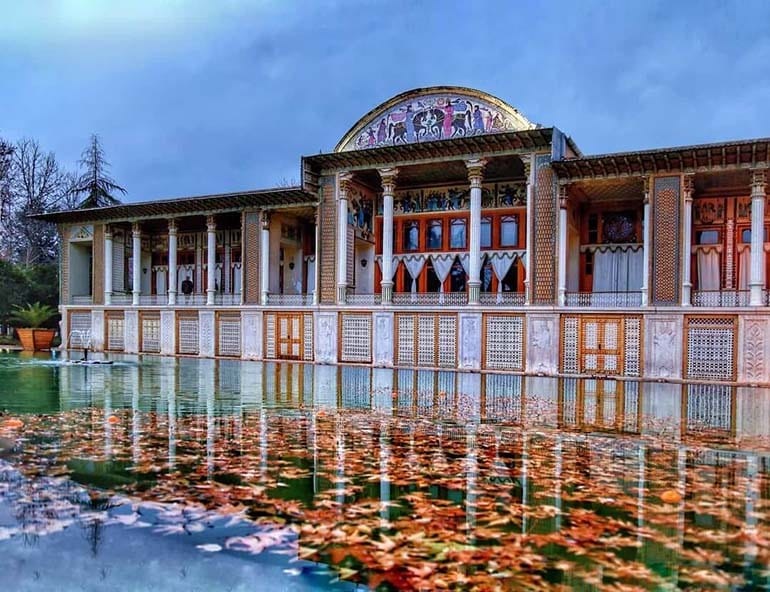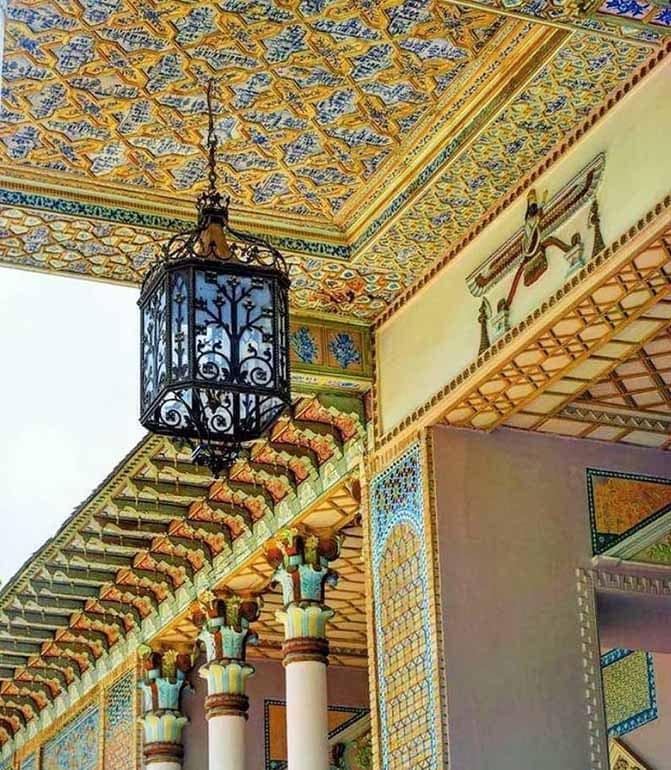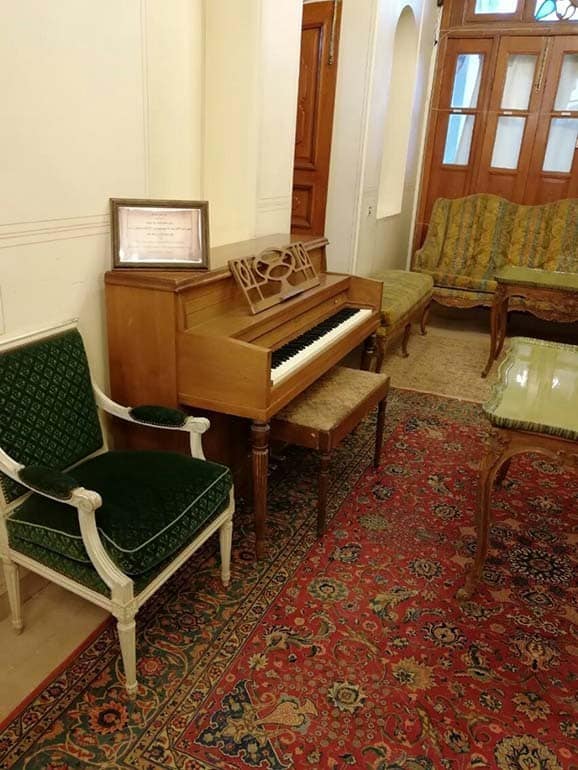Afif-Abad Garden: A Stroll Through Shiraz’s Historical Splendor

In this article from SURFIRAN travel magazine, we will provide you with complete information about Bagh-e Afif Abad in Shiraz, which many also know as Bagh-e Golshan Shiraz. This garden was built during the Safavid era and has undergone significant changes over the years. It has now been transformed into a military museum and a stunning garden for tourists to explore during their visit to Shiraz. Read on to learn more about the history of Bagh-e Afif Abad Shiraz and get familiar with the details of its various sections, so you can quickly navigate the garden when you arrive in Shiraz.
Contents
Where is Bagh-e Afif Abad Shiraz Located?
Address of Bagh-e Afif Abad Shiraz: Fars Province, Shiraz, at the end of Afif Abad Street.
You can reach Bagh-e Golshan Shiraz by bus, metro, taxi, or private car. If you plan to visit by bus, you should board buses heading to Esteghlal Boulevard and get off at Zarehi Bus Stop. From there, it’s just a short walk to the garden.
If you’re using the metro, go to Avini Metro Station and then take a taxi to Afif Abad Street and walk to the end of the street.
If you have a private car, you can easily find the route to Bagh-e Afif Abad Shiraz using Google Maps’ location feature.
History of Bagh-e Afif Abad Shiraz
Bagh-e Afif Abad Shiraz, covering an area of nearly 127,000 square meters, is one of Iran’s historical gardens that has survived the test of time, nestled amidst the historical slopes of Fars. During the Safavid era, it was known as one of the personal properties of the ruler of Fars, Ya’qub Khan Zolqadr, and served as a leisure retreat for the Safavid kings, featuring a massive stone castle at its center called Qaleh-e Golshan.
During the Qajar era, the garden was purchased by one of Shiraz’s powerful families, Mirza Ali Khan Qavam al-Mulk. Qavam al-Mulk issued orders for the renovation of the garden and acquired a qanat (a type of underground aqueduct) located 15 kilometers away for its irrigation.

As a significant portion of Qaleh-e Golshan had become dilapidated and in ruins, in 1905 AD, a beautiful two-story mansion replaced the old castle. This mansion is the same beautiful building that you can still see in Bagh-e Afif Abad Shiraz today. In the late Qajar era, the garden was entrusted to a woman named Afifeh Khanum, a niece of the garden’s benefactor. Afifeh Khanum made significant improvements to various parts of the garden, leading to the change in the garden’s name to Bagh-e Afif Abad.
In the Pahlavi era, the heirs of the garden presented it as a gift to Farah Pahlavi, but ultimately, the garden was acquired by the military through an auction in 1961. Following this event, Bagh-e Afif Abad underwent a seven-year restoration and reconstruction process, modeling after the Palace of Versailles.
Even after the 1979 revolution in Iran, the garden remained under the control of the military and was opened as Military Museum No. 2 on Army Day, April 18, 1991, allowing free access to all visitors. Bagh-e Afif Abad Shiraz was registered as a national heritage site in 1972.

Different Sections of Bagh-e Afif Abad Shiraz
Bagh-e Afif Abad Shiraz, as one of Shiraz’s historical and recreational attractions, features various sections. The garden complex includes royal palaces with two military museums and a moral museum, a bathhouse, a traditional teahouse, and an Iranian garden, all accessible for visitors. In the following sections, we will introduce you to these areas in more detail.
The Main Royal Palace

The main royal palace of Bagh-e Afif Abad Shiraz is a two-story mansion that bears architectural and structural resemblances to the Eram Garden in Shiraz. This mansion features 30 interconnected halls and rooms, creating a delightful fusion of Achaemenid, Sassanid, and Qajar architectural styles.
At first glance, your eyes will be drawn to a grand mansion with a spacious and open ivan (a central courtyard) surrounded by tall columns. Interestingly, all the rooms on the second floor open onto this ivan. In the ivan area, you’ll find a stunning mosaic depicting the coronation of one of the Sassanid kings, beautifully preserved for posterity.
In the main section of the mansion, on the northern side, a series of stone staircases will guide you to the primary hall. The entrance door features four columns with capitals resembling those of Persepolis. The most captivating aspect of this section is the wooden ceiling and oil-painted decorations that adorn the entire interior ceiling.

The eastern facade of Bagh-e Afif Abad Shiraz boasts a grand ivan, a defining element of the mansion’s exterior. On both sides of the building, there are two terraces known as “Bahar-khaneh” (Spring Houses) with eight columns each. Be sure to stroll around the mansion and take souvenir photos.
Military Museum
As you step onto the first floor of the Bagh-e Afif Abad mansion, you’ll be greeted by a blend of architecture and interior decorations illuminated by colorful lights streaming through the windows, creating a delightful ambiance that makes you feel as if you’re in a military museum.
One of the intriguing paradoxes of the Military Museum is the juxtaposition of dangerous and intricate weaponry in such an elegant setting. In the center of the hall, there’s a beautiful water feature reflecting the intricate designs on the walls and ceilings. The entire museum is adorned with wheat-ear pattern designs (a pattern resembling wheat, in a cream-colored background) on the walls, creating an impressive ambiance.

The Bagh-e Afif Abad Military Museum houses a vast collection of weaponry from various historical periods. It is considered one of the largest arms museums in the world. The museum displays an extensive array of both cold and firearms, swords, armor, rifles, cannons, and more. Notably, the museum showcases valuable and fascinating weapons used by prominent historical figures such as Fath Ali Shah, Naser al-Din Shah, Mohammad Reza Shah, Reza Shah, and Mozaffar al-Din Shah.
Moral Museum
The first floor of the mansion is connected to the second floor via three stairs. This floor is known as the Moral Museum, where personal belongings of the Pahlavi dynasty are displayed.
The museum consists of various sections, including a meeting room, a sitting area, a dressing room, a reading room, a reception area, and a gambling room. The authentic and valuable carpets in the rooms, as well as Farah Pahlavi’s personal piano, are among the most important items on display in the Moral Museum.
Iranian Garden
Bagh-e Afif Abad Shiraz is one of Iran’s most beautiful traditional gardens, with towering trees and beautiful flower arrangements that captivate the eyes of every traveler. The garden’s lush greenery makes it one of Shiraz’s most popular tourist attractions, providing an ideal place for leisurely walks and friendly gatherings.

The Iranian Garden resonates with the melodies of birds, the rustling of leaves in the wind, and the scent of blossoms. In spring, it comes alive with the fragrance of orange blossoms, while in summer, you can enjoy the scent of ripe oranges. Even in autumn and winter, its white and orange colors are captivating. Regrettably, the attention to the garden’s floral arrangements does not match its historical significance, but Bagh-e Golshan Shiraz remains the top choice for Shirazi residents seeking relaxation and a breath of fresh air.

Traditional Bathhouse
This traditional bathhouse is located in the western part of the Bagh-e Afifabad in Shiraz, Iran. The structure of the bathhouse is similar to other Iranian traditional bathhouses, but its traditional Iranian architecture has created a unique atmosphere. The interior walls of the bathhouse are adorned with prominent reliefs depicting famous ancient stories such as the story of Farhad on Bisotun Mountain, the encounter of people with Khosrow Parviz of the Sassanian Empire, and the scene of Joseph’s entry into the company of Egyptian women.

The traditional bathhouse of Bagh-e Golshan in Shiraz has two reservoirs for cold and hot water. The hot water reservoir was supplied by a large copper pot in the basement. In the past, by lighting a fire under the pot, the water gradually heated, and the smoke from the fire exited through the minaret on the roof of the bathhouse. The roof of the traditional bathhouse has a minaret and a small dome. This bathhouse has undergone maintenance and renovation over the years, and it can be said that it has somewhat departed from its former authenticity.

Traditional Teahouse
The traditional teahouse of Bagh-e Afifabad in Shiraz is located right next to the traditional bathhouse in the western part of the garden. In the past, this teahouse was a place for relaxation, entertainment, and hookah smoking for Qajar princes. The brick walls and Iranian architecture of the teahouse give a completely traditional ambiance to the space. It’s worth noting that there is also a small pool in the middle of the teahouse, adding to its charm.
The teahouse has six rooms adorned with designed tiles. The tile designs depict important stories from the Shahnameh, such as the story of Zahhak and Kaveh the Blacksmith, Zal and Simorgh, the battle between Rostam and Sohrab, the battle between Tahmoures and the White Demon, and the battle between Rostam and Esfandiyar. However, due to the commercialization of the building, the teahouse’s beauty from the old days is somewhat diminished, but it is still considered one of the attractions of Shiraz, and seeing the colorful and captivating Shahnameh images on the otherwise empty walls is a delight.

Various Amenities for Tourists in the Garden
As Bagh-e Afifabad in Shiraz is one of the most important tourist destinations in Shiraz, various amenities for the comfort and recreation of tourists and visitors have been provided. The garden’s amenities include a wedding hall and guesthouse, restrooms, a swimming pool, a traditional teahouse, restrooms, a bookshop, a handicrafts store, tennis and volleyball courts, and a booth for renting traditional clothing for photography.
The sports facilities and the hall and guesthouse are under the jurisdiction of the military, and their use is not open to everyone. To use these facilities, you must coordinate the necessary reservations.
Visiting Hours for Bagh-e Afifabad

Visiting Bagh-e Afifabad in Shiraz is possible from 8 AM to 7 PM in the first half of the year and from 8 AM to 5 PM in the second half of the year. The entrance ticket price for domestic tourists is 5,000 Iranian rials, while foreign tourists pay 50,000 Iranian rials.
Best Time to Visit the Garden
You’ve probably heard a lot about Shiraz and its unparalleled description in the spring, especially during the month of Ordibehesht. Spring is the best season to travel to Shiraz, but Bagh-e Afifabad in Shiraz is still attractive in other seasons, and visiting it will be an enjoyable experience.




